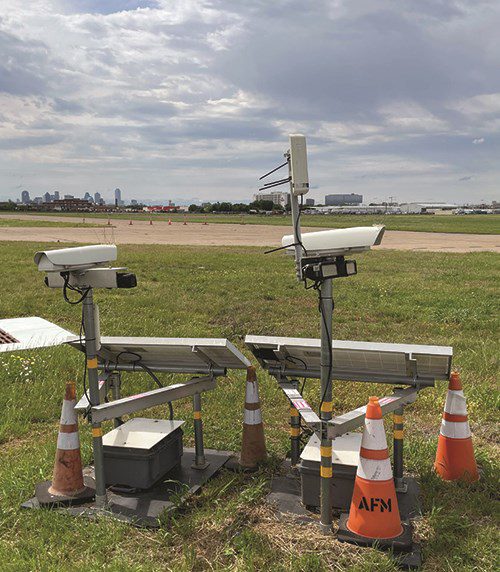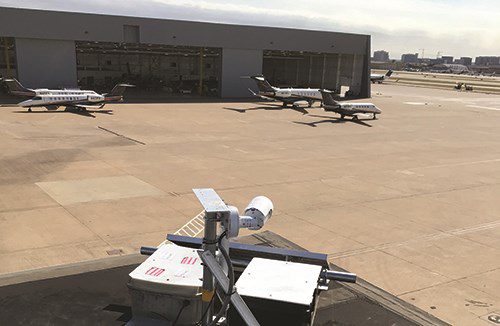A previous investment in an automated aircraft identification and billing system is paying new dividends at Dallas Love Field (DAL). The technology, PlanePass by Vector Airport Systems, was initially installed in 2016 to detect and bill Customs operations. DAL executives expanded its use in January 2019 to cover all general aviation and nonsignatory commercial operations.
A previous investment in an automated aircraft identification and billing system is paying new dividends at Dallas Love Field (DAL).
 The technology, PlanePass by Vector Airport Systems, was initially installed in 2016 to detect and bill Customs operations. But after the system proved its worth, DAL executives expanded its use in January 2019 to cover all general aviation and nonsignatory commercial operations. Since then, the airport has realized savings and captured significant amounts of previously uncollected revenue, reports Sheneice Hughes, assistant director of Administration and Customer Engagement.
The technology, PlanePass by Vector Airport Systems, was initially installed in 2016 to detect and bill Customs operations. But after the system proved its worth, DAL executives expanded its use in January 2019 to cover all general aviation and nonsignatory commercial operations. Since then, the airport has realized savings and captured significant amounts of previously uncollected revenue, reports Sheneice Hughes, assistant director of Administration and Customer Engagement.
“Before 2015, the Customs operation was pretty inefficient. Our Operations people, who already had many other responsibilities, were in charge of doing all the billing for Customs fees as well,” says Hughes. “There were five people involved in the billing process, and all of them had many other responsibilities. We were lucky to collect 70% of the fees owed to the airport.”
|
Project: Billing & Collecting Landing Fees Location: Dallas Love Field 2021 Annual Operations: 211,370 Automated System: PlanePass, from Vector Airport Systems Equipment: 7 camera pods, placed along critical taxiways & overlooking Customs area Equipment Cost: $137,581 Ongoing Cost: Airport pays Vector about 13% of landing fees collected Project Timeline: System originally deployed in 2016 for Customs operations; expanded in 2019 to cover all general aviation/commercial traffic Key Benefits: Increased revenue from previously uncollected general aviation landing fees; improved Customs fee revenues; less staff time required for billing; ability to audit self-reported data from commercial airlines |
The PlanePass system DAL deployed combines data from traditional flight tracking sources such as ADS-B, radar, multilateration and flight plans, with data from Vector’s aircraft identification camera pods, which capture tail numbers of aircraft landing at the airport 24 hours a day in all weather conditions. Combining multiple technologies allows the Vector system to capture all operations and maximize the airport’s revenue, Hughes explains.
The PlanePass system uses freestanding, solar-powered day/night wireless camera pods that are about 4 feet wide and 5 feet high. Each of DAL’s three major taxiways has a camera on each side, and another camera pod is fixed on a roof overlooking the Customs area.
Hughes reports that the cameras quickly proved their worth after going online in May 2016. Not only did DAL collect more landing fees, but employees also saved many hours previously spent dealing with billing issues. As a result, airport officials decided in 2018 to use the camera pods already in place to establish a new billing process for all general aviation aircraft.
Not surprisingly, that prompted pushback from airport users.
“Until then, DAL had never charged general aviation pilots landing fees,” Hughes explains. “Our three main commercial airlines—Southwest, Delta and Alaska—were paying all the operation and maintenance (O&M) costs through their landing fees, in which 80% was commercial and 20% was general aviation. So when we announced that we would start charging general aviation pilots beginning on Jan. 1, 2019, there was considerable resistance. We explained that the landing fees only would be to recoup the O&M costs for the runways—no more, no less.”
To further explain the rationale behind the new charges, DAL held six separate meetings throughout 2018. Attendees included pilots, representatives from fixed-based operators and jet charter companies, airport officials and executives from Vector.
 Company officials, including President Pete Coleton and Vice President Tom Breen, presented objective data in an attempt to assuage the unhappy airport users. “At times, it was contentious,” Coleton recalls. “In a given meeting, there might be Tom [Breen] and/or myself, one of the airport officials and about 30 to 35 skeptical airport users.
Company officials, including President Pete Coleton and Vice President Tom Breen, presented objective data in an attempt to assuage the unhappy airport users. “At times, it was contentious,” Coleton recalls. “In a given meeting, there might be Tom [Breen] and/or myself, one of the airport officials and about 30 to 35 skeptical airport users.
“This was a tough sell for the airport, since the pilots and private companies were being hit with a new expense. We were there to support airport officials in their presentations.”
Breen explains that they shared detailed information about how Vector’s landing fee system had worked at other airports. “We gave several case examples of how different types of aircraft were charged at those airports, so this gave the pilots at DAL at least some idea of what types of fees were commonplace at similar airports and the efficiencies offered by the PlanePass system,“ he says.
 “We also emphasized that once they got used to the new system, they would see that it would eventually save them a lot of time, in that all of their fees would be accumulated automatically, and they would get one monthly bill from Vector,” Breen adds. “And we showed what those bills looked like.”
“We also emphasized that once they got used to the new system, they would see that it would eventually save them a lot of time, in that all of their fees would be accumulated automatically, and they would get one monthly bill from Vector,” Breen adds. “And we showed what those bills looked like.”
Coleton reports that after many meetings, the majority of stakeholders from the pilot community seemed to accept that the fee was reasonable. Moreover, airport officials told attendees at each meeting that they could avoid landing fees altogether by using nearby Dallas Executive Airport, which is operated by DAL. “I think it is telling that not one of those attendees decided to leave our airport,” Hughes shares.
Cutting Red Tape
Because DAL is owned by the city of Dallas, the initial $137,500 the airport spent to purchase Vector’s PlanePass equipment had to be approved by the City Council. As a standard rule, all city-owned facilities need to get bids from at least three separate providers for purchases of such magnitude. For DAL, that caused delays because no other company offered a product or service similar to PlanePass. The airport distributed a request for proposal that also was posted on its website, but no other company responded. After a few months, the city sanctioned the purchase, and the airport signed a contract with Vector in August 2015. The final step was getting FAA approval, which took another few months. Once that was granted, the installation itself only took a few weeks, and the system went online in May 2016.
When DAL expanded its use of the system to all general aviation traffic a few years later, it didn’t need to purchase any new equipment. Hughes and her team simply modified the original contract with Vector. Under this arrangement, DAL pays the company a fixed cost of approximately 13% of all landing fees that are collected, including international arrivals and general aviation. Variables that affect landing fee billing include the volume of aircraft, average aircraft weight and the complexity of the fee structure. Some airports have a list of aircraft that are exempt from landing fees, and those must be tracked and excluded from the billing process.
Here’s how it works at DAL: Vector captures the aircraft operations data using several technologies, fuses that data together, generates the invoices for landing/customs fees, and then delivers them to thousands of DAL aircraft operators. It also staffs a U.S.-based, live call center to answer questions about the invoices and help facilitate payment if needed. Airport officials review the monthly reports, authorize Vector to claim its agreed-upon portion, and then receive the balance of the collected landing fees. For example, in February 2022, international flights were charged approximately $111,000 in landing fees, and general aviation operators and commercial charters were charged approximately $554,000. As those invoices were collected, Vector was authorized to retain 13% to cover the cost of PlanePass operations, including equipment service and maintenance. The airport then received the remaining 87% of collections.
An entirely different system is used at DAL to collect landing fees from commercial airlines with scheduled service. Instead of using PlanePass, the airport audits the figures provided in monthly reports from the FAA control tower and sends bills directly to each of the airlines.
The reports that PlanePass provides about airline operations do, however, still come into play by helping the airport audit carriers’ self-reported data. Hughes notes that DAL used to pay about $75,000 per year for flight tracking data from another vendor to use for comparative purposes, but it has since been able to eliminate those costs since the PlanePass system provides commercial aircraft operations data to DAL as part of its service.
Safeguarding the Data
Vector’s standard sales agreement with airports includes installation of hardware and software. At DAL, the company is also responsible for maintaining and repairing the seven camera pods that record aircraft tail numbers for billing purposes. Many of the company’s airport customers opt for similar contracts including service and maintenance.
In the last four years, the Vector equipment at DAL has required major repair twice. Once, a bad windstorm completely destroyed a unit, and the company replaced it at no extra cost. In the other instance, a large lawn mower operating at night significantly damaged a camera pod. In that case, a Vector technician flew down and fixed it the next day, with associated costs being covered in the original service agreement.

When the equipment needs service or repair, it automatically sends alerts to Vector’s automated monitoring system, which then reports to both Vector and airport maintenance staff. Vector coordinates with airport maintenance staff to diagnose and correct such issues. Typically, an airfield maintenance team member drives onto the field and examines the equipment in question, with a Vector technician on the phone. If a major fix is needed, a Vector employees flies to DAL to repair the equipment.
“Most maintenance staff at our client airports drive around to inspect the runways and taxiways every day anyway,” Coleton says. “They can usually easily pop by to put eyes on any equipment that is causing a maintenance alert. Problems are rare and usually easy to fix. We learn something with every repair, and improve our equipment to be tougher and more reliable with teach build.”
The Vector systems installed at the airport have several layers of built-in storage redundancy to prevent the loss of aircraft operations data in the event of transmission failures. Company personnel note that the overall system is very tolerant to outages of any particular technology, because the system uses multiple technologies to derive aircraft operations data.
The company will adjust the location of camera pods on request. For example, if an airport has a construction project that affects the runway and/or taxiway, the company will move the camera pods to another taxiway for use during the construction. This occurred at DAL earlier this year during the reconstruction of one of the primary runways.
Win-Win Proposition
With the PlanePass system in place at DAL for three years, much of the initial skepticism voiced by airport users has subsided. “By now, both the pilots and the airport realize we offer a very convenient service by simplifying the billing process,” states Breen. “In many ways, using PlanePass is similar to using the I-PASS or E-ZPASS transponders now commonplace [for road vehicles] in many states. Few drivers want to wait in a long line at a toll booth when they can just zip by at highway speed with one of those transponders. We speed up our customers’ billing processes with our proprietary technology.”
The system is especially popular with large charter operators and fractional aircraft ownership companies, he adds. “NetJets flies into all 37 of the airports we service, and we do $28 million in total billings from them alone,” says Breen. “We just send them one bill based on their operations at each airport.”
Looking ahead, he predicts that business jet operations—and associated billings for landing fees—are likely to increase. “Business jet sales are soaring after the COVID pandemic; manufacturers can’t make enough of them,” he says. “We expect that billings from this segment of the industry will increase at Love Field and at our other client airports.”
According to Hughes, the new billing system is already helping boost DAL’s balance sheet. “Just collecting landing fees since 2019 has been a big difference,” she says. “Better yet, we now are assured of getting nearly 100% of all the landing fees owed to us.”
The less-apparent benefit of using the automated system is relieving internal burdens associated with collecting landing fees. “I figure it has saved us thousands of manpower hours, enabling these people to devote their energies to other matters,” Hughes explains.
The program has been so successful at DAL, the airport extended its contract with Vector by five years last March. “As we anticipate steady growth for the next few years, a smooth, efficient billing process in the future will be very beneficial,” Hughes concludes.


 facts&figures
facts&figures

